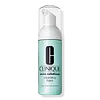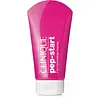What's inside
What's inside
 Key Ingredients
Key Ingredients

 Benefits
Benefits

 Concerns
Concerns

 Ingredients Side-by-side
Ingredients Side-by-side

Salicylic Acid 2%
MaskingWater
Skin ConditioningGlycerin
HumectantButylene Glycol
HumectantSodium Methyl Cocoyl Taurate
CleansingSucrose
HumectantDisodium Phosphate
BufferingArginine Cocoate
Skin ConditioningLaminaria Saccharina Extract
Skin ProtectingCola Nitida Seed Extract
Skin ConditioningCaffeine
Skin ConditioningAlgae Extract
EmollientMentha Piperita Callus Lysate
AntioxidantSea Whip Extract
Skin ConditioningPEG/PPG-18/18 Dimethicone
EmulsifyingSodium Hyaluronate
HumectantPPG-6
Skin ConditioningDecyltetradeceth-30
CleansingLactobacillus Ferment
Skin ConditioningStearamidopropyl Dimethylamine
EmulsifyingLongifolene
MaskingAcetyl Glucosamine
Skin ConditioningCapryloyl Glycine
CleansingPerillaldehyde
Masking10-Hydroxydecanoic Acid
Skin ConditioningPolyquaternium-7
Beta-Caryophyllene
MaskingPhospholipids
Skin ConditioningSodium Stearate
CleansingSodium Salicylate
PreservativeDisodium EDTA
Phenoxyethanol
PreservativeChloroxylenol
AntimicrobialSalicylic Acid 2%, Water, Glycerin, Butylene Glycol, Sodium Methyl Cocoyl Taurate, Sucrose, Disodium Phosphate, Arginine Cocoate, Laminaria Saccharina Extract, Cola Nitida Seed Extract, Caffeine, Algae Extract, Mentha Piperita Callus Lysate, Sea Whip Extract, PEG/PPG-18/18 Dimethicone, Sodium Hyaluronate, PPG-6, Decyltetradeceth-30, Lactobacillus Ferment, Stearamidopropyl Dimethylamine, Longifolene, Acetyl Glucosamine, Capryloyl Glycine, Perillaldehyde, 10-Hydroxydecanoic Acid, Polyquaternium-7, Beta-Caryophyllene, Phospholipids, Sodium Stearate, Sodium Salicylate, Disodium EDTA, Phenoxyethanol, Chloroxylenol
Water
Skin ConditioningGlycerin
HumectantSodium Laureth Sulfate
CleansingSilica
AbrasiveAcrylates Copolymer
Lauramidopropyl Betaine
CleansingButylene Glycol
HumectantSucrose
HumectantCocamidopropyl Hydroxysultaine
CleansingCarica Papaya Fruit Extract
Skin ConditioningBambusa Arundinacea Stem Extract
Skin ConditioningLaminaria Saccharina Extract
Skin ProtectingSalicylic Acid
MaskingPalmitoyl Tetrapeptide-7
Skin ConditioningPalmitoyl Tripeptide-1
Skin ConditioningCaffeine
Skin ConditioningSodium Hyaluronate
HumectantAcetyl Glucosamine
Skin ConditioningSodium Coco Pg-Dimonium Chloride Phosphate
CleansingPolysorbate 20
EmulsifyingDisodium Cocoyl Glutamate
CleansingCitric Acid
BufferingSodium Cocoyl Glutamate
CleansingLaureth-2
CleansingSodium Chloride
MaskingSodium Hydroxide
BufferingSodium Sulfate
Carbomer
Emulsion StabilisingMonosodium Citrate
BufferingDisodium EDTA
EDTA
BHT
AntioxidantPhenoxyethanol
PreservativeCI 15510
Cosmetic ColorantCI 19140
Cosmetic ColorantCI 14700
Cosmetic ColorantWater, Glycerin, Sodium Laureth Sulfate, Silica, Acrylates Copolymer, Lauramidopropyl Betaine, Butylene Glycol, Sucrose, Cocamidopropyl Hydroxysultaine, Carica Papaya Fruit Extract, Bambusa Arundinacea Stem Extract, Laminaria Saccharina Extract, Salicylic Acid, Palmitoyl Tetrapeptide-7, Palmitoyl Tripeptide-1, Caffeine, Sodium Hyaluronate, Acetyl Glucosamine, Sodium Coco Pg-Dimonium Chloride Phosphate, Polysorbate 20, Disodium Cocoyl Glutamate, Citric Acid, Sodium Cocoyl Glutamate, Laureth-2, Sodium Chloride, Sodium Hydroxide, Sodium Sulfate, Carbomer, Monosodium Citrate, Disodium EDTA, EDTA, BHT, Phenoxyethanol, CI 15510, CI 19140, CI 14700
Ingredients Explained
These ingredients are found in both products.
Ingredients higher up in an ingredient list are typically present in a larger amount.
Acetyl Glucosamine is an antioxidant and humectant. It is an amino acid sugar and is naturally found in our skin.
The cool thing about this ingredient? It helps the skin produce hyaluronic acid and boost hydration. It also has antioxidant benefits to protect skin cells.
When paired with niacinamide, Acetyl Glucosamine has been shown to be effective at reducing discoloration.
Learn more about Acetyl GlucosamineButylene Glycol (or BG) is used within cosmetic products for a few different reasons:
Overall, Butylene Glycol is a safe and well-rounded ingredient that works well with other ingredients.
Though this ingredient works well with most skin types, some people with sensitive skin may experience a reaction such as allergic rashes, closed comedones, or itchiness.
Learn more about Butylene GlycolCaffeine is most associated with coffee, tea, and cacao. In skincare, it helps with calming inflammation and is rich in antioxidants.
While caffeine is used to treat cellulite and and dark circles, further studies are needed to prove this. It has been believed to help with these skin conditions due to its ability to dilate blood vessels and increase blood flow.
Some studies are looking into caffeine's ability to protect against UV rays.
Learn more about CaffeineDisodium EDTA plays a role in making products more stable by aiding other preservatives.
It is a chelating agent, meaning it neutralizes metal ions that may be found in a product.
Disodium EDTA is a salt of edetic acid and is found to be safe in cosmetic ingredients.
Learn more about Disodium EDTAGlycerin is already naturally found in your skin. It helps moisturize and protect your skin.
A study from 2016 found glycerin to be more effective as a humectant than AHAs and hyaluronic acid.
As a humectant, it helps the skin stay hydrated by pulling moisture to your skin. The low molecular weight of glycerin allows it to pull moisture into the deeper layers of your skin.
Hydrated skin improves your skin barrier; Your skin barrier helps protect against irritants and bacteria.
Glycerin has also been found to have antimicrobial and antiviral properties. Due to these properties, glycerin is often used in wound and burn treatments.
In cosmetics, glycerin is usually derived from plants such as soybean or palm. However, it can also be sourced from animals, such as tallow or animal fat.
This ingredient is organic, colorless, odorless, and non-toxic.
Glycerin is the name for this ingredient in American English. British English uses Glycerol/Glycerine.
Learn more about GlycerinWe don't have a description for Laminaria Saccharina Extract yet.
Phenoxyethanol is a preservative that has germicide, antimicrobial, and aromatic properties. Studies show that phenoxyethanol can prevent microbial growth. By itself, it has a scent that is similar to that of a rose.
It's often used in formulations along with Caprylyl Glycol to preserve the shelf life of products.
Salicylic Acid (also known as beta hydroxy acid or BHA) is a well-known ingredient for treating skin that struggles with acne and clogged pores. It exfoliates both the skin's surface and deep within the pores to help clear out buildup, control oil, and reduce inflammation.
Unlike AHAs (alpha hydroxy acids), salicylic acid is oil-soluble. This allows it to penetrate into pores which makes it especially effective for treating blackheads and preventing future breakouts.
Salicylic acid is also known for its soothing properties. It has a similar structure to aspirin and can calm inflamed or irritated skin, making it a good option for acne-prone skin that is also sensitive.
Concentrations of 0.5-2% are recognized by the U.S. FDA as an over-the-counter topical acne product.
It can cause irritation and/or dryness if one's skin already has a compromised moisture barrier, so it's best to focus on repairing that before introducing this ingredient into your routine.
While salicylic acid does not increase sun sensitivity, it’s still important to wear sunscreen daily to protect your skin.
If you are looking for the ingredient called BHA or Butylated Hydroxyanisole, click here.
Learn more about Salicylic AcidSodium Hyaluronate is hyaluronic acid's salt form. It is commonly derived from the sodium salt of hyaluronic acid.
Like hyaluronic acid, it is great at holding water and acts as a humectant. This makes it a great skin hydrating ingredient.
Sodium Hyaluronate is naturally occurring in our bodies and is mostly found in eye fluid and joints.
These are some other common types of Hyaluronic Acid:
Learn more about Sodium HyaluronateSucrose is a natural sugar found in fruits, vegetables, and nuts. It is the main constituent of white sugar.
In skincare, sucrose is a humectant and can be a mild exfoliant.
Sucrose is hydrophilic, meaning it attracts water. This makes it an effective humectant and helps hydrate the skin.
Studies show sugars may worsen acne-prone skin due to it disrupting the skin's natural biome. We recommend speaking with a professional if you have any concerns.
In some products such as body scrubs, sucrose is used as an gentle exfoliant.
The term 'sucrose' comes from the french word for sugar, 'sucre'.
Learn more about SucroseWater. It's the most common cosmetic ingredient of all. You'll usually see it at the top of ingredient lists, meaning that it makes up the largest part of the product.
So why is it so popular? Water most often acts as a solvent - this means that it helps dissolve other ingredients into the formulation.
You'll also recognize water as that liquid we all need to stay alive. If you see this, drink a glass of water. Stay hydrated!
Learn more about Water